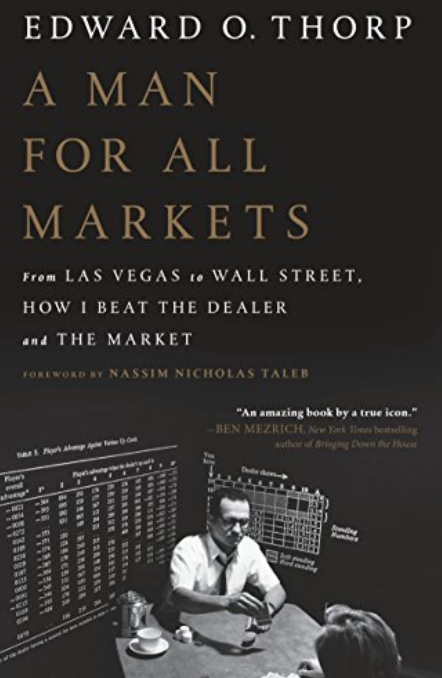Investing Lessons from the Man Who Beat the Casinos
Ed Thorp is a brilliant guy who used math to beat the casinos at blackjack, roulette, and other games. Along the way, he was drugged, threatened, and cheated by casino bosses who initially mocked his published methods. Unable to get the winnings his systems deserved he pivoted to using his math prowess on investing, figuring that gambling is investing simplified.
Ed Thorp is the first modern mathematician who successfully used quantitative models for risk taking – and most certainly the first mathematician who met financial success doing it.
Nassim Nicholas Taleb
He didn’t mean that investing, like gambling, is a crap shoot. But you can analyze both using math, statistics, and computers. Risk management and proper bet sizing are also important in both.
While we can’t replicate Thorp’s math brilliance, there are investing lessons to be learned from him, which he shared in his excellent autobiography, A Man for All Markets.

Lessons from A Man for All Markets by Ed Thorp
Read voraciously.
Be rational and disciplined.
Do the analysis. Ignore stories, sales pitches, and gut reactions.
Ignore the news.
Offering explanations for significant prices changes is a recurrent event in financial reporting. The reporters often don’t know whether a fluctuation is statistically common or rare.
Ed Thorp
Protecting Your Portfolio From The News dives into this in greater detail.
Avoid fear and greed. Chasing hot returns and market timing when you’re nervous lead to poor results.
Anchoring is a major behavioral investing mistake. An example: holding onto a stock you’re losing money on until you break even is anchoring to your initial purchase price. The market doesn’t care what you paid for the stock, and what matters is finding the best investment from here on out.
Access to capital is key. If you don’t have enough saved, it won’t matter how much your portfolio earns. Ed Thorp’s methods led him to identify more investment opportunities than he could profit from with his limited capital. So he tapped into OPM – Other People’s Money – in this instance by running a hedge fund. OPM has turned lots of brilliant investors into billionaires, but one source of it carries extra risk – leverage.
Leverage is dangerous. Assume the worst will happen and then stress test your finances to see if you can withstand it. If not, borrow less. Using Debt Smartly to Build Wealth will help with your analysis.
Beating the market is extremely difficult. Doing so requires finding a statistically significant edge and being a stronger analyst than the competition. The good news is you don’t have to be a great investor to get wealthy.
Whether or not you try to beat the market, you can do better by properly managing your wealth.
Ed Thorp
Asset allocation, tax planning, estate planning, sound decision-making, saving money, and protecting your capital are important and accessible ways to build wealth for the average investor.
Invest primarily in stocks, bonds, and real estate. Stocks and commercial real estate provide the strongest long-term returns, although Thorp wasn’t as confident about the real estate data. And with stocks expect big and lengthy portfolio drops. Thorp calls them “savage reductions in wealth”. Ride them out.
A Man for All Markets gets into Thorp’s specific asset allocation approach. He favors stocks when they’re cheap relative to bonds, and bonds when their yields are high compared with the earnings yield on stocks.
Looking for a Wealth-Building Framework?
Receive a free copy of my Personal Finance Book
Beyond the Basics: Maximizing, Allocating, and Protecting Your Capital
